By Paul Couillard

Rachel Rosenthal | November 9, 1926 – May 10, 2015
Going to see Rachel Rosenthal’s Gaia, Mon Amour in Ottawa in 1983 changed my life, prompting me to become both an artist and a vegetarian. Rachel’s activist performance work showed me that art could be used to care both about and for the world. Most importantly, she revealed to me the transformative possibilities of performance. More than anything, what she conveyed to me was the urgent necessity of approaching this life with respectful courage. Rachel was a brilliant and inspirational presence, profoundly loving, concerned, thoughtful, and uncompromising. Yet it was no secret that she often found humans—herself included—to be an obstinate, exasperating and extremely dangerous breed, and that she generally preferred the company of nonhuman sentient beings—The Others, as she called them in one of her many politically and personally charged works. Animals and the earth were her great passions. She was deeply committed to sounding the alarm about how humans are destroying our planet, warning us that our vast power as a species is only surpassed by our ignorance and arrogance.
I was fortunate enough to know Rachel in a variety of contexts: as an audience member, as one of her students, as a producer of her workshops and performances, as a colleague, and as a friend. A master practitioner of the time-honoured mentor/apprentice relationship, Rachel schooled more than one generation of artists, myself included. Aside from calling me to artistry, she provided me with an invaluable education and encouraged the development of my career. After I studied with her in Los Angeles, for example, she wrote me a recommendation letter that was crucial to my first successful grant application.
When I brought Rachel to Ottawa to present an intensive series of workshops with the local community in 1989, she stayed in my home. Every evening we would discuss what had happened in the workshop that day, her observations interspersed with stories of her own past: her Paris childhood, where artists like Jascha Heifetz and Marc Chagall were not uncommon guests at the dinner table; her early adulthood in New York, where she shared a studio with Jap (Jasper Johns) and Bob (Robert Rauschenberg); her move to Los Angeles after being encouraged by her friend John (Cage)… What was deeply empowering for me was the way she referred to these legendary figures exactly the same way she talked about the participants in the workshops. For her, our ideas, our struggles, our achievements were just as engaging and worthy of consideration as those of her more famous peers. We were all artists, and her stories were generously encouraging lessons from someone who knew too well the challenges of battling insecurity and developing self-respect. She was already close to 50 before the feminist movement taught her that the terms ‘woman’ and ‘artist’ were not mutually exclusive, and so she could be both. Having inhabited self-doubt so thoroughly, one of her greatest skills and gifts as a teacher was encouraging others to believe in themselves and in the possibilities open to them.
Although it was through performance art that she finally achieved a certain level of international fame, her most fundamental inspiration came from Antonin Artaud’s The Theatre and Its Double. Artaud’s book provided the blueprint she needed to craft an original form for her protean talents, which spanned a gamut of disciplines (performer, director, visual artist, writer, teacher). Her technically proficient and dramatically accomplished solo performance works were always richly theatrical: carefully scripted, populated with intense and compelling personas, and offering a dense layering of lighting, projections, soundtracks, costumes and props. At the root of her virtuosity, however, was an array of improvisational techniques and exercises that she had pioneered, which also provided the basis for her classes and workshops. Long before she became a famous performance artist, she was an important figure in California’s experimental underground art scene in the 1950s and ’60s, directing and performing with her improvisational theatre company, Instant Theatre. Those early performances, crafted around the classic literary canon of fairy tales and fables, were never documented, but their legacy continues in the ongoing work of The Rachel Rosenthal Company, an improvisationally based performance art troupe drawn from her students and nurtured through her artistic vision.
Rachel’s classes were often a sounding board for the ideas that were central to the performances she was working on at the time. When I studied with her in the mid 1980s, Rachel was musing about the potential of performance artists as modern-day, secular shamans. Human civilizations have always had institutions and rituals to help them feel connected: to each other, to the land and creatures that surround and sustain us—and indeed, that we are a part of; and to a larger sense of the cosmos. The need to feel and make meaning of these relationships on a corporeal level, in our bones and flesh, did not disappear with the tidy mind/body split of the Enlightenment era. But what part of our culture now fulfils such a role and provides us with a collective sense of belonging? It is doubtful that an entertainment ‘industry’ tailor-made for a capitalist infrastructure offers the best model for addressing this essential human need. There is a yawning social gap across modern societies, and Rachel encouraged her students to think about how they might address this through their work. While most contemporary constructions of performance art tend to trace the form’s roots back to early 20th Century avant garde art movements. Rachel was interested in a much older and more expansive cultural lineage.
In 2000, 7a*11d sponsored a residency project with Rachel in Toronto. Because this was an expensive event, FADO was brought on as a co-producer. Originally scheduled for 1999 as the festival’s first “off-year” project after we switched to a biennial format, the residency had to be rescheduled after Rachel developed pneumonia. This was a major project for both 7a*11d and FADO, and Rachel brought with her an entourage of technical crew to manage her show and document her work. During her visit, she conducted master classes for local artists and presented a two-day run of a major new work, UR-BOOR. In fact, Toronto was the last leg of the production’s tour and the site of her final performance on a public stage. Although she continued to teach and to direct her company, the event marked her retirement from solo performance.
This is one of two production footnotes to Rachel’s career that I played a part in. I was also the only person ever to produce her 3-day, 35-hour DbD Workshop outside of Los Angeles. Considered one of her signature activities, DbD (also the name of her performance studio, Espace DbD: the name originated from a beloved cat, Dibidi, but also came to stand for “doing by doing,” which she felt was an apt description of her method) was widely hailed as a powerful transformative event for artists and non-artists alike. Beginning on a Friday evening with a 6-hour opening session, and continuing through two 14-and-a-half hour sessions on Saturday and Sunday, the workshop was designed as a personal and collective journey through guided meditations, exercises and improvisations. Carefully structured yet always infused with the unique energy of the assembled group, the experience was accurately described by Linda Burnham as a “mind/body spa.”[1] One did not have to be an artist to participate, but the secret of the DbD workshop’s transformative success was its crafting of a collective art-making process.
Like her performances, which were often infused with a kind of shimmering luminosity, Rachel’s workshops and classes felt like a natural breeding ground for the kind of heart-stopping and time-stopping moments that become etched into one’s memory as definitional, legendary. Rachel had her own phrase for these moments, especially when, during a “blow-it-out-your-ass” improv (her name for the madcap group sessions that she often used to end a class), serendipity would bring together an unlikely, unpredictable but astonishingly affective confluence of actions and images: “The djinn are with us,” she would say. Hers was a kind of magic that few can conjure, let alone teach, If she was not a djinni herself, surely Rachel spent a great deal of her time in their company.[2]
—Paul COUILLARD
[1] Linda Burnham, “The DBD Experience. Rachel Rosenthal’s Mind/Body Spa: A Bath for the Soul,” High Performance 7:2 (1984): 52-53.
[2] The details of this text are based on my own recollections of and conversations with Rachel, but there are many books, articles, interviews and recordings documenting her life and work. For those interested in getting a sense of her voice, I particularly recommend a remarkable oral history interview with Rachel by Moira Roth, recorded in September of 1989 and available in both audio and text transcript formats in the Archives of American Art: aaa.si.edu/collections/interviews/oral-history-interview-rachel-rosenthal-13200

Born in Paris, Rachel Rosenthal’s talents spanned a gamut of disciplines (performer, director, visual artist, writer, teacher). First recognized as an underground personality for her experimental Instant Theatre company, then becoming an important figure in the Los Angeles women’s art movement of the 1970s, she eventually gained international fame as a performance artist and as the Artistic Director of the Rachel Rosenthal Company. Her pioneering work integrated a total theatrical experience with committed, urgent messages, creating an unforgettable live art experience. An N.E.A. and J. Paul Getty Foundation Fellow, the recipient of numerous awards including an Obie, and declared a Living Cultural Treasure by the City of Los Angeles, Rosenthal was also a powerful environmental and animal rights activist. Rachel Rosenthal was featured in a special artist residency cosponsored by 7a*11d and FADO in 2000.
